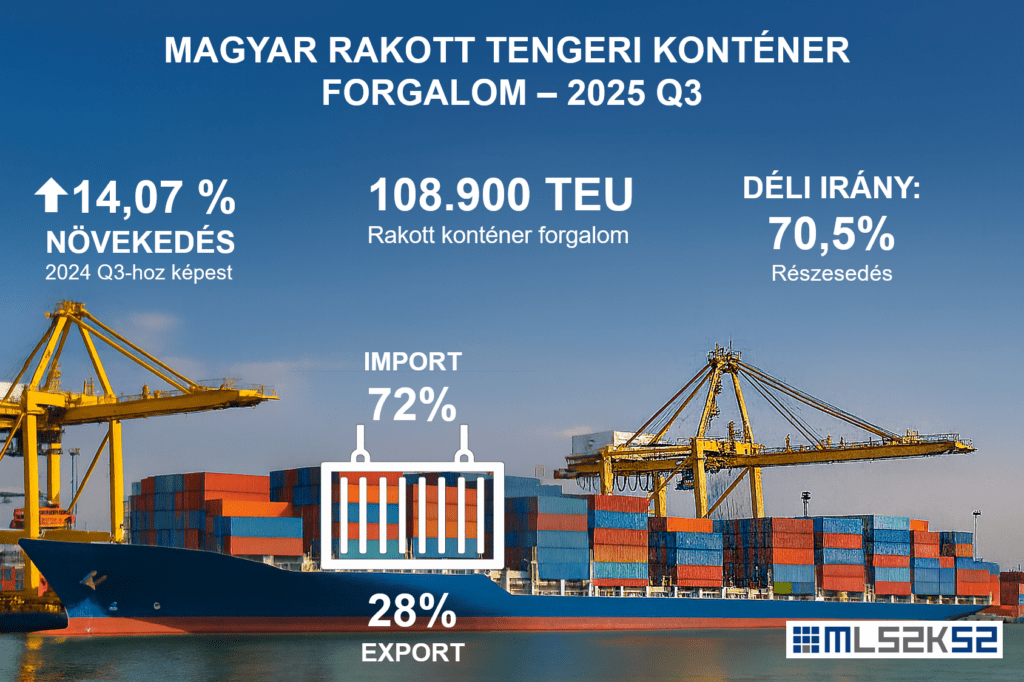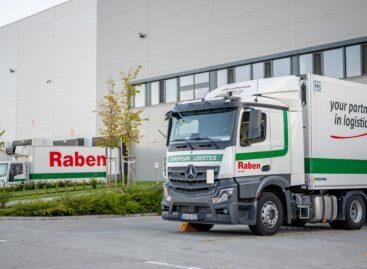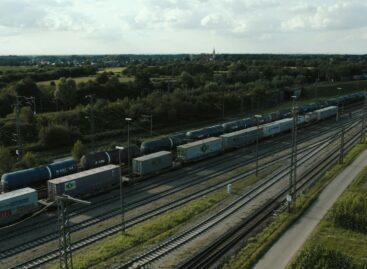Hungarian maritime container traffic continues to soar
After the disruptions in global supply chains, Hungarian sea routes have picked up again: in the third quarter of 2025, loaded container traffic increased by more than 14 percent, reaching a historic high for the sector. Southern ports’ traffic broke all previous records, while the factory construction wave and Adriatic routes drive imports. Hungary is thus becoming an increasingly important regional logistics hub.

Hungarian sea loaded container traffic also showed strong growth in the third quarter of 2025, with traffic increasing by 14.07 percent compared to the same period in 2024. Following the fluctuations of previous years, the sector has been on a stable growth path for the second year in a row. The growth engine continues to be imports, driven by demand for factory building raw materials and the expansion of household consumption.
According to data from the Association of Hungarian Logistics Service Centers (MLSZKSZ), the Hungarian sea-loaded container intermodal market reached 108,900 TEU loaded traffic in the third quarter of 2025, which is more than 12,000 TEU higher than a year earlier. The import ratio was 72 percent, the export ratio was 28 percent, and the southern direction remained dominant, with a share of 70.5 percent.
The role of southern ports continues to strengthen
The traffic of southern ports increased by 115 percent compared to the third quarter of 2024, while that of the northern direction increased by 108 percent. The largest growth was achieved by the Adriatic routes – mainly Koper and Rijeka – which once again confirmed their leading position for the Hungarian market. The new Rijeka terminal, which started operating in September, gradually can take over part of the traffic of other Adriatic ports, contributed to the increase in traffic.
However, despite the favorable trends, the market also faces challenges: there is persistent congestion in the ports of Koper and Hamburg, rail transport is disrupted, and containers often have to wait weeks for delivery. The planned railway renovations may also cause disruptions, which is expected to lead to a further strengthening of road transport in the south.
Regional expansion and new connections
Hungarian terminals are increasingly serving the sea container traffic of Western Romania and Northern Serbia, thus strengthening the intermodal network of the region. With shipments coming from the Curtici, Arad and Teiuș areas, Hungary is also playing an increasingly important role as a logistics hub in the Adriatic freight transport.
Sea freight rates are still more favorable compared to rail routes, but the rearrangement of competition between shipping companies has created a new situation. Four of the nine shipping companies active in Hungary were able to increase their quarterly traffic, which is a weaker ratio than in the previous quarter. According to the MLSZKSZ, this is a consequence of the logistical rearrangements related to the transformation of the federation systems and the avoidance of the Suez Canal.
Positive outlook for the end of the year
According to the federation’s forecast, further traffic growth is expected in the fourth quarter as well, as demand for imports may remain permanently high, and the impact of new infrastructure developments – such as the Rijeka terminal – will be felt gradually.
The traffic data in the announcement covers 100 percent of the Hungarian sea container intermodal market, as they are based on data provided by all terminals and shipping companies active in the market in Hungary..
Related news
Time is the most precious commodity – Christmas peak in logistics
🎧 Hallgasd a cikket: Lejátszás Szünet Folytatás Leállítás Nyelv: Auto…
Read more >Transporters protested against the planned toll increase in Budapest and its surroundings
🎧 Hallgasd a cikket: Lejátszás Szünet Folytatás Leállítás Nyelv: Auto…
Read more >The Ministry of Transport invites transport organizations to the negotiating table
🎧 Hallgasd a cikket: Lejátszás Szünet Folytatás Leállítás Nyelv: Auto…
Read more >Related news
Christmas shock in commerce: for the first time, we can pay with bank cards in fewer places
🎧 Hallgasd a cikket: Lejátszás Szünet Folytatás Leállítás Nyelv: Auto…
Read more >Hungarian Confectionery Manufacturers Association: trends in 2025 and prospects for 2026
🎧 Hallgasd a cikket: Lejátszás Szünet Folytatás Leállítás Nyelv: Auto…
Read more >Most grocery chains will be open until noon on December 24th
🎧 Hallgasd a cikket: Lejátszás Szünet Folytatás Leállítás Nyelv: Auto…
Read more >






